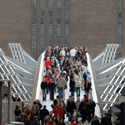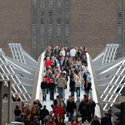All together now
The steps of pedestrians walking on bridges, the firing of neurons in the brain, and the phases of photons emitted by atoms in a laser are all examples where spontaneous synchronization of an ensemble of oscillators occurs in the absence of an external clock. In these systems, a mean field, generated by the single oscillators and felt by all of them, drives the oscillators to move in lock-step.
The underlying mechanism for spontaneous synchronization has been understood and summarized by the so-called Kuramoto model, which is based on the assumption that the phase of each oscillator is attracted by the average phase of all the others. Now, a paper appearing in Physical Review E from David Mertens and Richard Weaver at the University of Illinois in Urbana-Champaign offers evidence that the same formalism can describe an acoustic analog to the laser.
The authors model an experimental system (described in a separate publication) where feedback forms between simple, eccentrically weighted dc motors, such as those found in cell phones, and an underlying resonant cantilever. The speed of the motors determines the frequency with which the cantilever oscillates, while the support vibration induces an effective torque to the motors and affects their speed.
By generalizing the Kuramoto model to resonant coupling, Mertens and Weaver are able to account for several aspects of the motor oscillators that could in turn be useful for describing a broad class of oscillator ensembles spanning disciplines from laser physics to mechanical engineering to neuroscience. – Antonio Politi





